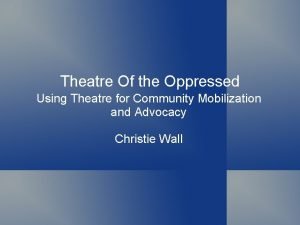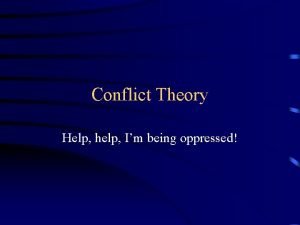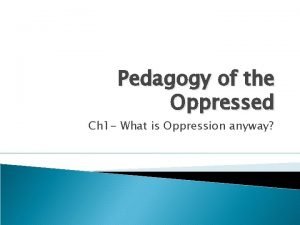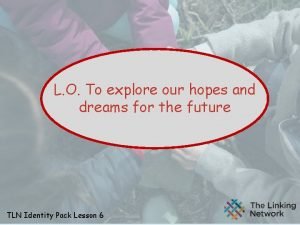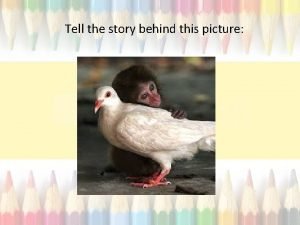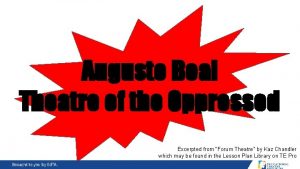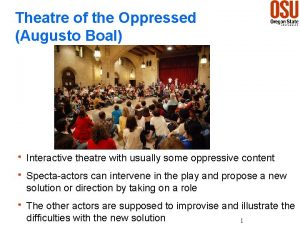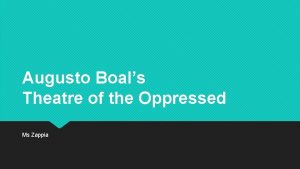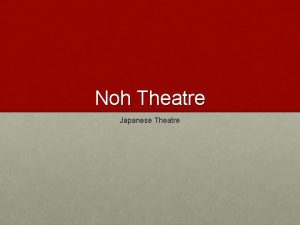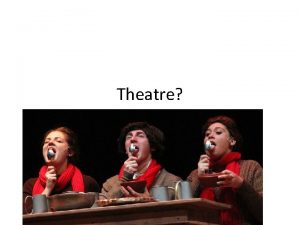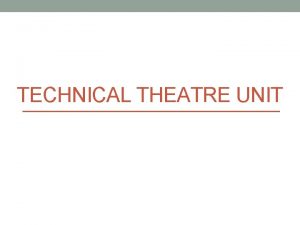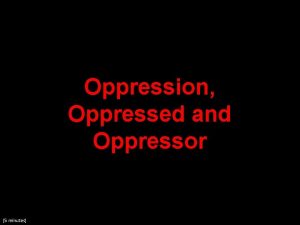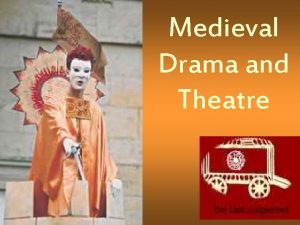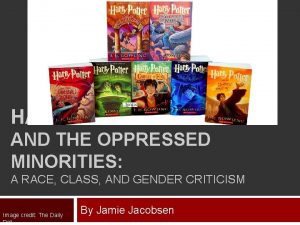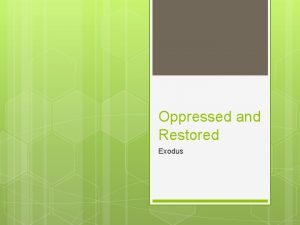Using Theatre of the Oppressed to explore and



















- Slides: 19

Using Theatre of the Oppressed to explore and heal trauma Daniel Domaguin Deborah Kawkeka (Kickapoo) 2017 American Indian and Alaska Native Behavioral Health Conference Tulsa, OK August 15 -17, 2017

Objectives 1) 2) 3) Understand the benefits of integrating embodied art into behavioral health treatment, particularly for conflict, suicide prevention and addiction Implement at least three Theatre of the Oppressed techniques into treatment practice Explore theoretical and historical foundations of Theatre of the Oppressed

Why is understanding trauma important? (SAMHSA, 2012) � To provide effective services, we need to understand the life situations that may be contributing to the person’s current life problems � Many current problems faced by the people we serve may be related to traumatic life experiences � People who have experienced traumatic life events may be very sensitive to situations that remind them of the people, places, or things involved in their traumatic event ◦ These reminders (triggers) may cause a person to relive the trauma and view our setting/organization as a source of distress rather than a place of healing and wellness

Non-trauma vs trauma informed What’s wrong with you? What has happened to you?

Conflict Traumainfluenced behaviors Addiction Suicidality

How can creative arts expression, embodied art in particular, be trauma informed?

“Art is a safe way to express our feelings; it helps us express ourselves slowly and at our own pace. Art goes beyond words and tells our story for us. It helps us delve into our true selves and express our pains and heartaches that language does not have the ability or power to convey. Feelings that stem from trauma, violence, or abuse are often overwhelming and words alone rarely capture or convey their true intensity. Pictures tell us far more than words can ever express. Tapping into our artistic selves and creative mind can help provide a whole world of selfdiscovery. Art is the best healing tool possible when we are feeling emotions that are too painful, too deep, too hidden to access—much less to express. ” Anna Reyner, MA From the essay “How Art Heals Us”

Creative arts expression and trauma informed care � Recognizes difficulty in dealing with trauma and its symptoms ◦ Client can go at their own pace � Is client-focused and -centered: provider may not exhibit power/control over client ◦ “You must do BLANK treatment” � The creation of art can be a collaborative, back-and-forth, shared process between provider and client

Embodied art � Allows client to express emotions and thoughts using their body � Exhibiting certain body poses/postures can cause hormonal changes that configure the brain to feel more assertive and comfortable vs shut-down (Cuddy, 2012) Retrieved from https: //youtu. be/t. Y 7 Ls. NRAz 4 w

Theatre of the Oppressed � Founded during a period of political upheaval and military dictatorship in 1960 s Brazil by theatre practitioner/chemist Augusto Boal � Created to resist governmental oppression and corruption, during a time that theatre was outlawed Retrieved from http: //www. azquotes. com/picture-quotes/ Retrieved from http: //dramaresource. com/wp-content/uploads/2014/12/boal-1. png

Theatre of the Oppressed by Paolo Friere’s seminal work Pedagogy of the Oppressed, which rejects “traditional” Western education’s “banking model” of filling empty vessels (students) with knowledge, instead calling on building of critical consciousness among students/teachers/society � Inspired Retrieved from https: //biaesmer. files. wordpress. com/2014/03/paulo_freire_a. jpg

Some principles of TO The basic aim of the Theatre of the Oppressed is to humanize Humanity. � Every human being is theatre! � Theatre is defined as the simultaneous existence - in the same space and context - of actors and spectators. Every human being is capable of seeing the situation and seeing themselves in the situation. � The oppressed are those individuals or groups who are socially, culturally, politically, economically, racially, sexually, or in any other way deprived of their right to Dialogue or in any way impaired to exercise this right. � “Forever Free, ” Edmonia Lewis (Mississauga Ojibwe), marble, 1867

What does “oppression” look like?

In vivo TO exercises � Gift Game � Machines � Statues � Museum of the Unspeakables Retrieved from https: //youtu. be/t. Y 7 Ls. NRAz 4 w

A Window Between Worlds � � � Mission A Window Between Worlds is dedicated to cultivating and supporting a network of transformative arts programs that empower individuals and communities impacted by violence and trauma. Vision A Window Between Worlds views art as a catalyst to release trauma, build resilience and ignite social change. When individuals create art in a safe community they can be heard and respected — replacing violence and shame with safety and hope. Website: http: //awbw. org

Free TO resources

Discussion � How may these exercises assist in approaching: ◦ Conflict ◦ Suicidality ◦ Addiction � Thoughts � Wonders � Observations

Works cited �A Window Between Worlds. (2014). Windows Theatre of the Oppressed Community Gathering. Retrieved from https: //youtu. be/t. Y 7 Ls. NRAz 4 w � Cuddy, Amy. (2012). Your body language may shape who you are. TED Talk retrieved from https: //www. ted. com/talks/amy_cuddy_your_body_la nguage_shapes_who_you_are/transcript? language=en #t-786345 � Reyner, A. (2015). How art heals us. Retrieved from http: //www. care. uci. edu/docs/How-Art. Heals_AWBW. pdf � SAMHSA. (2012). The ABCs of trauma informed care. Retrieved from https: //www. integration. samhsa. gov/mai-cocgrantees-online-community/ABCs_of_Trauma. New. pdf

Thank you! � Daniel Domaguin ◦ Behavioral Health Clinical Manager ◦ (916) 929. 9761 x 1516 ◦ ddomaguin@crihb. org � Deborah Kawkeka (Kickapoo) ◦ Training Coordinator ◦ (916) 929. 9761 x 1514 ◦ dkawkeka@crihb. org
 Tree of theatre of the oppressed
Tree of theatre of the oppressed Im being oppressed
Im being oppressed Pedagogy of the oppressed chapter 1
Pedagogy of the oppressed chapter 1 Uwsom explore and focus
Uwsom explore and focus College physics: explore and apply 2nd edition answers
College physics: explore and apply 2nd edition answers Our hopes and expectations
Our hopes and expectations The story behind this picture
The story behind this picture Hát kết hợp bộ gõ cơ thể
Hát kết hợp bộ gõ cơ thể Bổ thể
Bổ thể Tỉ lệ cơ thể trẻ em
Tỉ lệ cơ thể trẻ em Chó sói
Chó sói Tư thế worms-breton
Tư thế worms-breton Hát lên người ơi
Hát lên người ơi Các môn thể thao bắt đầu bằng tiếng chạy
Các môn thể thao bắt đầu bằng tiếng chạy Thế nào là hệ số cao nhất
Thế nào là hệ số cao nhất Các châu lục và đại dương trên thế giới
Các châu lục và đại dương trên thế giới Công của trọng lực
Công của trọng lực Trời xanh đây là của chúng ta thể thơ
Trời xanh đây là của chúng ta thể thơ Cách giải mật thư tọa độ
Cách giải mật thư tọa độ
